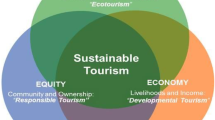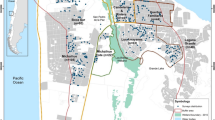Abstract
The formation of rills and gullies represents an important indicator of land degradation and generates some of the highest erosion rates in the world. Nonetheless, in certain places, badland sites characterized by intense rill and gully erosion have become important natural tourist attractions. Many parts of Turkey are subjected to these types of erosion, but the possibility of using badlands as geomorphosites for tourism and education has yet to be explored. The area around Küpyar Hill, Manisa Province, hosts an interesting assemblage of landforms that have developed as a result of intensive rilling and gullying. These features have attracted the attention of local mountaineering and nature sports clubs, and this has helped to enable the area to become a tourist destination. The main objective of this study was to evaluate whether the landform assemblage hereabouts has the potential to be designated as a geomorphosite for tourism and education. Initially, it was necessary to identify all the clubs that include this region in their activity programs. Thereafter, it was possible to conduct face-to-face interviews with club managers, to obtain information about their routes, and to analyze photographs on the basis of pictorial semiotics. A questionnaire was completed by 108 individuals who visited Küpyar. The results suggest that visitors are not well informed about the processes that have led to formation of the rills and gullies, but there is a clear interest in these features and their development. The esthetic, economic, educational, scientific, and touristic value of the region was analyzed within the framework of different geomorphosite assessment methods. Those areas characterized by rilling and gullying were delimitated during detailed field research, and a geomorphosite map was produced with two routes that can be used for geotourism and geoeducation. Protecting this area as a geomorphosite appears to represent the most progressive decision that could be taken in terms of land use planning. Moreover, it could help to generate new sources of income for the local people and stem emigration from rural settlements to neighboring towns and cities.









Similar content being viewed by others
References
Akbulut G (2016) Geotourism in Turkey. In: Egresi I (ed) Alternative tourism in Turkey. Springer, Cham, pp 87–107. https://doi.org/10.1007/978-3-319-47537-0_6
Brilha J (2016) Inventory and quantitative assessment of geosites and geodiversity sites: a review. Geoheritage 8:119–134. https://doi.org/10.1007/s12371-014-0139-3
Bruno DE, Perrotta P (2012) A geotouristic proposal for Amendolara territory (northern ionic sector of Calabria, Italy). Geoheritage 4:139–151. https://doi.org/10.1007/s12371-011-0047-8
Chaplot V, Coadou le Brozec E, Silvera N, Valentin C (2005) Spatial and temporal assessment of linear erosion in catchments under sloping lands of northern Laos. Catena 63:167–184. https://doi.org/10.1016/j.catena.2005.06.003
Çiftçi Y, Güngör Y (2016) Proposals for the standard presentation of elements of natural and cultural heritage within the scope of geopark projects. Bull Miner Res Explor 153:223–238. https://doi.org/10.19111/bmre.80846
Clark R (1980) Erosion condition classification system. United States Department of the Interior, Bureau of Land Management, technical note no. 346. Denver, Colorado
Coratza P, De Waele J (2012) Geomorphosites and natural hazards: teaching the importance of geomorphology in society. Geoheritage 4:195–203. https://doi.org/10.1007/s12371-012-0058-0
Egresi I (2016) Alternative tourism in Turkey. Springer, Cham. https://doi.org/10.1007/978-3-319-47537-0
Ekinci D (2010) The noticeable geomorphosites of Turkey. Int J Arts Sci 3:303–321
Erinç S (1955) Orta Ege Bölgesinin jeomorfolojisi. MTA Rapor No 2217
Farsani NT, Coelho CO, Costa CM, Amrikazemi A (2014) Geo-knowledge management and geoconservation via geoparks and geotourism. Geoheritage 6:185–192. https://doi.org/10.1007/s12371-014-0099-7
General Directorate of Mineral Research and Exploration (2019) Geoscience Map Viewer and Drawing Editor. http://yerbilimleri.mta.gov.tr/anasayfa.aspx. Last accessed 30 October 2019
Geofabrik (2019) https://www.geofabrik.de/data/. Last accessed 30 October 2019
Grandgirard V (1997) Géomorphologie, protection de la nature et gestion du paysage. PhD Thesis, Université de Fribourg
Ielenicz M (2009) Geotope, geosite, geomorphosite Ann Valahia Univ Târgovişte. Geogr Ser 9:7–22
JEMİRKO (2019) Geological heritage inventory recommendation form. Available at: https://www.jemirko.org.tr/download/envanter-listesi-detayli/?wpdmdl=180. Last accessed 30 October 2019
Kaya A (2013) Turgutlu ilçesinin coğrafyası. PhD Thesis, Afyon Kocatepe Üniversitesi
Kayan İ (1997) Yeni yaklaşımlarla Türkiye’nin Plio-Kuaterner paleocoğrafyası. A.Ü. Türkiye Coğrafyası Araştırma ve Uygulama Merkezi Dergisi 6:189–197
Kazancı N, Şaroğlu F, Doğan A, Mülazımoğlu N (2012) Geoconservation and geoheritage in Turkey. In: Wimbledon WAP, Smith-Meyer S (eds) Geoheritage in Europe and its conservation. ProGeo, Oslo, pp 366–377
Koçman A (1985) İzmir-Bozdağlar yöresinin yapısal jeomrfolojisi ve evrimi. Ege Coğrafya Dergisi 3:63–86
Koçman A (1989) Uygulamalı fiziki coğrafya çalışmaları ve İzmir Bozdağlar yöresi üzerine araştırmalar. Ege Üniversitesi Edebiyat Fakültesi Yayınları, İzmir
Kubaliková L (2013) Geomorphosite assessment for geotourism purposes. Czech J Tour 2:80–104. https://doi.org/10.2478/cjot-2013-0005
Kuzucuoğlu C, Çiner A, Kazancı N (2019) Landscapes and landforms of Turkey. Springer, Cham. https://doi.org/10.1007/978-3-030-03515-0
Nadal-Romero E, Martínez-Murillo JF, Vanmaercke M, Poesen J (2011) Scale-dependency of sediment yield from badland areas in Mediterranean environments. Prog Phys Geogr 35:297–332. https://doi.org/10.1177/0309133311400330
Nita J, Myga-Piątek U (2014) Geotourist potential of post-mining regions in Poland. Bull Geogr, Phys Geogr Ser 7:139–156. https://doi.org/10.2478/bgeo-2014-0007
Ólafsdóttir R, Tverijonaite E (2018) Geotourism: a systematic literature review. Geosciences 8:234. https://doi.org/10.3390/geosciences8070234
Palacio-Prieto JL, Rosado-González E, Ramírez-Miguel X, Oropeza-Orozco O, Cram-Heydrich S, Ortiz-Pérez MA, Figueroa-Mah-Eng JM, Fernández de Castro-Martínez G (2016) Erosion, culture and geoheritage; the case of Santo Domingo Yanhuitlan, Oaxaca, Mexico. Geoheritage 8:359–369. https://doi.org/10.1007/s12371-016-0175-2
Panizza M (2001) Geomorphosites: concepts, methods, and examples of geomorphological survey. Chin Sci Bull 46(S1):4–5. https://doi.org/10.1007/BF03187227
Pereira P, Pereira D (2010) Methodological guidelines for geomorphosite assessment. Géomorphologie: relief, processus, environnement 16:215–222. https://doi.org/10.4000/geomorphologie.7942
Philippson A (1911) Reisen und Forschungen im westlichen Kleinasien II: Ionien und das westliche Lydien. Perthes, Gotha
Pralong JP (2005) A method for assessing tourist potential and use of geomorphological sites. Geomorphologie: Relief, Processes, Environnement 3:189–196. https://doi.org/10.4000/geomorphologie.350
Reynard E (2009) Geomorphosites: definitions and characteristics. In: Reynard E, Coratza P, Regolini-Bissig G (eds) Geomorphosites. Verlag Dr. Friedrich Pfeil, München, pp 9–20
Reynard E, Fontana G, Kozlik L, Scapozza C (2007) A method for assessing scientific and additional values of geomorphosites. Geogr Helv 62:148–158. https://doi.org/10.5194/gh-62-148-2007
Serrano E, González-Trueba JJ (2005) Assessment of geomorphosites in natural protected areas: the Picos de Europa National Park (Spain). Géomorphologie: Relief, Processus, Environnement 11:197–208. https://doi.org/10.4000/geomorphologie.364
Solarska A, Hose TA, Vasiljević DA, Mroczek P, Jary Z, Marković SB, Widawski K (2013) Geodiversity of the loess regions in Poland: inventory, geoconservation issues, and geotourism potential. Quat Int 296:68–81. https://doi.org/10.1016/j.quaint.2012.08.2057
Tepeci M, Günlü E, İnci S, Karaköse E, Zurnacı N, Onağ AO, Kaygalak S, Dama B, Kavak Y (2015) IPARD programı ile Manisa’da kırsal turizmin geliştirilmesi stratejileri projesi. Tarım ve Kırsal Kalkınmayı Destekleme Kurumu Manisa İl Koordinatörlüğü, Manisa
UNEP (1994) United Nations conventions to combat desertification in those countries experiencing serious drought and/or desertification, particularly in Africa. United Nations Treatise Series, Paris
Vardar S (2018) Lidyanın Tmolos (Bozdağlar) Yaylalarında Jeomorfoloji, Paleocoğrafya ve Jeoarkeoloji Araştırmaları. Kriter Yayınevi, İzmir
Warowna J, Zgłobicki W, Gajek G, Telecka M, Kołodyńska-Gawrysiak R, Zieliński P (2014) Geomorphosite assessment in the proposed geopark Vistula river gap (E Poland). Quaest Geogr 33:173–180. https://doi.org/10.2478/quageo-2014-0040
Warowna J, Zgłobicki W, Kołodyńska-Gawrysiak R, Gajek G, Gawrysiak L, Telecka M (2016) Geotourist values of loess geoheritage within the planned geopark Małopolska Vistula River gap, E Poland. Quat Int 399:46–57. https://doi.org/10.1016/j.quaint.2015.06.064
Yolal M (2012) Geotourism and geoparks: the case of Kızılcahamam-Çamlıdere Geopark. Geoj Tour Geosites 5:193–203
Zgłobicki W, Baran-Zgłobicka B (2013) Geomorphological heritage as a tourist attraction. A case study in Lubelskie Province, SE Poland. Geoheritage 5:137–149. https://doi.org/10.1007/s12371-013-0076-6
Zgłobicki W, Kołodyńska-Gawrysiak R, Gawrysiak L, Pawłowski A (2012) Geotourism assets of loess relief in western part of the Lublin upland. Przegl Geol 60:26–31
Zgłobicki W, Kołodyńska-Gawrysiak R, Gawrysiak L (2015) Gully erosion as a natural hazard: the educational role of geotourism. Nat Hazards 79:159–181. https://doi.org/10.1007/s11069-014-1505-9
Zgłobicki W, Poesen J, Daniels M, Del Monte M, Guerra AJT, Joshi V, Paterson G, Shellberg J, Solé-Benet A, Su Z (2018) Geotouristic value of badlands. In: Nadal-Romero E, Martínez-Murillo JF, Kuhn NJ (eds) Badland dynamics in the context of global change. Elsevier, Amsterdam, pp 277–313. https://doi.org/10.1016/B978-0-12-813054-4.00009-5
Zgłobicki W, Poesen J, Cohen M, Del Monte M, García-Ruiz JM, Ionita I, Niacsu L, Machová Z, Martín-Duque JF, Nadal-Romero E, Pica A, Rey F, Solé-Benet A, Stankoviansky M, Stolz C, Torri D, Soms J, Vergari F (2019) The potential of permanent gullies in Europe as geomorphosites. Geoheritage 11:217–239. https://doi.org/10.1007/s12371-017-0252-1
Zouros N (2007) Geomorphosite assessment and management in protected areas of Greece. Case study of the Lesvos Island—coastal geomorphosites. Geogr Helv 62:169–180. https://doi.org/10.5194/gh-62-169-2007
Acknowledgments
I would like to express my sincere thanks to the managers and members of Olympos Mountaineering & Nature Sports Club Turgutlu Branch, Spilos Mountaineering & Trekking, Turgutlu Motocross Club, Turgutlu Mountaineering & Nature Sports Club (TURDAK), Turgutlu Youth Mountaineering & Nature Sports Club (TURGEDAK), and Zirve Mountaineering & Nature Sports Club Turgutlu Branch who shared relevant information with me and participated in my questionnaire. I would also like to offer my gratitude to Abdullah Aydın, undergraduate in the Department of Geography, Uşak University, who provided assistance with the field research. I would like to extend my cordial thanks to Dr. Matt Rowberry, Institute of Rock Structure & Mechanics ASCR, for his contribution to the improvement of the language in the manuscript.
Author information
Authors and Affiliations
Corresponding author
Appendix 1
Appendix 1


Rights and permissions
About this article
Cite this article
Güney, Y. The Geomorphosite Potential of the Badlands Around Küpyar, Manisa, Turkey. Geoheritage 12, 21 (2020). https://doi.org/10.1007/s12371-020-00433-y
Received:
Accepted:
Published:
DOI: https://doi.org/10.1007/s12371-020-00433-y




